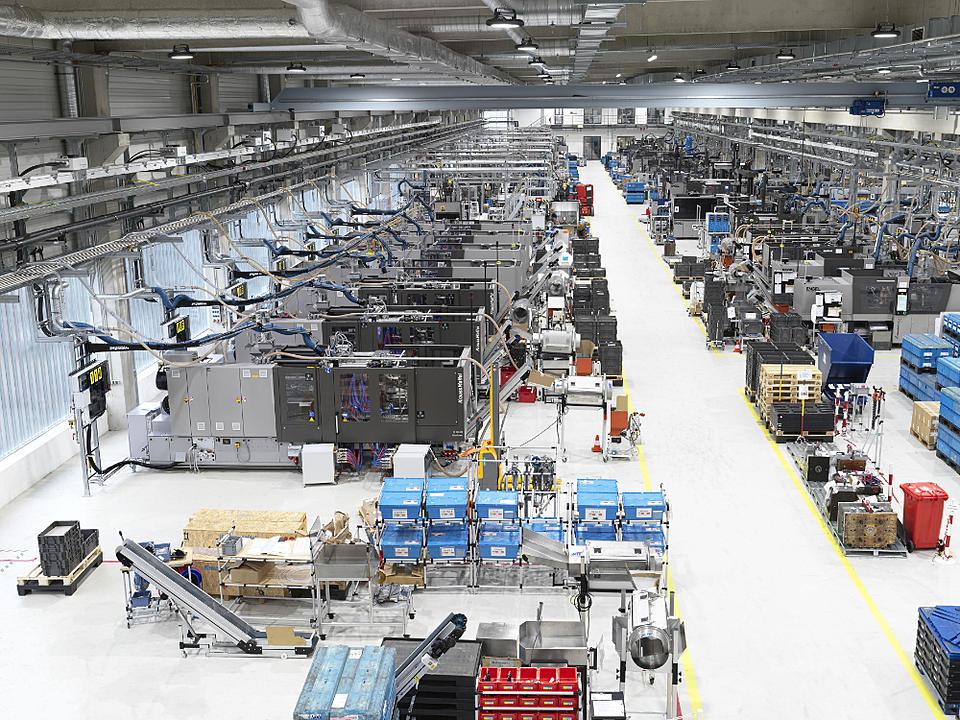Summarize this content in well-structured paragraphs in German language and keep HTML tags Ensinger GmbH, headquartered in Nufringen, produces technical parts made of plastic. In the early days it was strongly focused on mechanical engineering, but over the course of its history the company has repeatedly found new business areas.
Photos: Ensinger GmbH
A room with display cases full of different objects: In addition to parts for medical technology such as handles for surgical scissors or instruments for dental technology, sealing rings and other components for machines are displayed behind glass. What at first glance appears to be a bit thrown together has one big thing in common: the parts were made from plastic – using an injection molding process. This means that melted plastic is pressed into a specific shape using special machines.
All parts were manufactured by Ensinger GmbH, which develops and produces at the main factory in Nufringen and in an injection molding factory in Rottenburg-Ergenzingen. The company produces technical parts for machines, plastic rods and plates, profiles and composites, i.e. materials that consist of at least two different materials. All products are made of high-performance plastics. The advantages of these materials are diverse: For example, the high-performance plastics can withstand particularly high temperatures and can be processed very easily, which makes them usable in many areas.
Ensinger’s products can be found in almost all important industrial sectors, in mechanical and vehicle construction, in medical technology and in aviation. “The products we manufacture can be found in all areas of industry where longevity is required,” says Oliver Stiegen, head of the injection molding technology division at Ensinger.
Always open up new business areas
The Ensinger story began in a garage near Böblingen. There, company founder Wilfried Ensinger began working with plastics in 1966: Using machines he designed himself, he developed new processes to press the plastic into specific shapes and use it to make parts for machines, for example. In the 1970s, the range was expanded and the company began producing machine elements made of plastic using so-called machining. Excess material is removed mechanically, giving the component a new shape. Thermal insulation was added at the end of the 1970s – Ensinger now also manufactured plastics for the insulation of aluminum windows and facades. In 1985, Ensinger began producing plastic parts using injection molding.
Since the automotive industry was the largest customer in the early years, the company’s initial focus was primarily on plastic parts from the transmission and drive sector. For special machines, for example, Ensinger produces slide rails that are optimized so that they show less abrasion and therefore less wear than conventional metal rails. Over time, new areas played an increasingly important role. Ensinger parts are now also used in space travel or the energy sector, for example. Ensinger also produces parts for the interior fittings and landing gear of aircraft; Ensinger plastic parts are used for solar sails and cable insulation in satellites. Ensinger’s plastic parts are also used on drilling rigs and in wind turbines in the form of seals, valves, locking rings and gears. In the recent past, manufacturing has become increasingly important to the semiconductor industry. “Our process is cheaper than the silicon wafers traditionally used in semiconductor production. The injection molded parts are also easier to process,” explains Stiegen. New types of drive also play a role at Ensinger. For example, many Ensinger parts can be found in electric motors: “Our components use a special combination of materials to help increase the range of electric vehicles,” says Stiegen. Today Ensinger is considered one of the leading providers in the field of plastics processing. “By continually expanding our product selection, we have developed from a small business into a true global player.”
High-tech material plastic
“You can say that modern plastics are high-tech materials,” says Stiegen. “In the injection molding division, we use so-called high-performance plastics that are enhanced with auxiliary materials. These auxiliary materials can be carbon fibers, glass fibers or other materials that increase the strength of the components. This means that conventional components made of metal and ceramic can be replaced.”
The material with which all Ensinger products are manufactured is not only versatile, it is also sustainable: “Engineering plastics help save weight and therefore often fuel, reduce the use of lubricating oils and greases and reduce maintenance costs reduce,” explains Stiegen. “As a result, these plastics reduce the ecological footprint of the components in which they are used.” Ensinger also strives to reuse excess material that is produced during the manufacture of individual parts. “We melt down large parts of rejects and production residues ourselves and reuse the material. What we don’t need, we sell to other companies who recycle the plastic material.”
Family business in demand worldwide
Today, 2.600 employees at 33 locations in Europe, North and South America, Asia and in the Stuttgart and Neckar-Alb regions look after plastic products. “For us, the Stuttgart region clearly means home. The company was founded here, we have enjoyed being here for over 50 years and want to stay here,” says Stiegen, adding: “There are many customers and business partners here, and we find talent and highly qualified specialists here. There are many universities and research institutes. The workforce feels comfortable here because it is simply a high-quality life.” The fact that Ensinger has remained a family business despite the international expansion also plays a role, says Stiegen: “Our managers and teams work together in partnership, too with our customers and suppliers because we maintain an open and familiar relationship with each other.”
ensingerplastics.com/de












